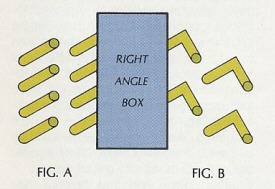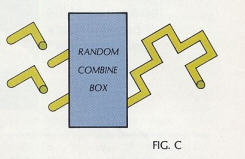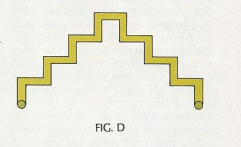A challenge to the prevailing scientific view
that life comes from a chance combination of material elements.
Edited from an original paper
Although scientists would like to assume that in the past, inert chemicals combined to produce life, as yet no one has ever observed such an event. In addition, although scientists have many theories about how life is working inside the cell, they have not been able to combine the constituent chemicals to form living cells, even in controlled laboratory settings. Thus, the claim of molecular biologists that life has come about by evolutionary development beginning from a primordial environment of methane, ammonia, and water sparked by an electromagnetic or thermal stimulus has never been substantiated by experimental evidence. Although scientists have found traces of amino acids (the building blocks of biological molecules) in reaction chambers filled with ammonia, methane, and water, the formation of these simple amino acids does not prove that life evolved by a chance combination of chemicals. Amino acids are a very long way from a living organism, so there is really no substantial justification for concluding that this common laboratory experiment proves life originated by chance in a "primordial chemical soup."

Nor have the biologists found a chemical which, when injected into a dead organism, will restore life. In fact, they are having a difficult time explaining the activities of the living cell by chemical equations. Physicist Louis de Broglie has commented, "It is premature to reduce the vital processes to the quite insufficiently developed conceptions of nineteenth and twentieth century physics and chemistry." And even if the microbiologist does try to analyze a living cell in the detail necessary to discover its exact chemical activity, he would have to kill it, obliterating with his instruments the very principle of "life" he was seeking in the first place. Consequently, many scientists are now looking for new concepts beyond chemistry and physics to explain how life works. These new attempts are called holistic approaches, which consider the living organism as a whole and view life as complementary to matter.
Nevertheless, most materialistic scientists reject this idea. They ignore the fact that living systems defy the second law of thermodynamics, which strictly governs inert matter. According to this law, no complex system of chemical reactions can maintain itself indefinitely. Yet living systems do maintain themselves, generation after generation, without any loss of complex order. Therefore we can safely say that life does not act according to the laws of chemistry and physics, and that it is perfectly scientific to talk of life as a principle separate from matter.
Also, from the point of view of mathematics and logic, we can see that complex living organisms cannot arise spontaneously from unorganized matter; there must be the touch of higher intelligence. Suppose we have a collection of short rods (A). If we then pass them through a box that combines the rods two at a time, at right angles to each other, we shall arrive at B. Then suppose we join the L's together at random. We can see that the final configuration C has no greater form than that which was explicitly specified in the system going from A to B to C. In other words, for C to have a specific, complex structure, we have to supply specific, complex information to create that structure. A random pairing of L's cannot produce a complex, organized pattern. For example, if we wanted to generate the structure below, (D) we would have to supply explicit information at each step of the operation. In other words, all the information specifying the final structure must be available throughout the development of the structure. The basic mathematical theorems of Kolmogorov and Chaitin ** (1. G.J. Chaitin, "Information-Theoretic Computational Complexity," IEEE Transactions, Institute of Electrical and Electronic Engineers, IT-20 (1974), pp. 10-15.) governing so-called complexities of formal systems confirm this argument. In general, all of this proves that something simple cannot create something complex by a random process. And when we apply this conclusion to the current theory of evolution, we see that random atoms and molecules couldn't possibly have developed into complex living forms without an outside source of information.
As we have seen, known scientific principles such as those of thermodynamics, mathematics, and logic confirm that life comes from life, not from matter. Also, it is a fact of experience that a living plant comes from another living plant, an amoeba comes from an amoeba, a dog from a dog, and a human being from another human being. On the other hand, no one has ever observed a living entity coming from dead matter. Despite all this evidence, however, most scientists still cling to the theory that life comes from matter. Why?
The strongest arguments of the evolutionists are based on the fossil record. However, objective analysis of the fossil record reveals a different story than the one the evolutionists would have us believe. First, it is an admitted fact that after one hundred years of digging, practically no fossils of intermediate species (the famous "missing links") have ever been found to confirm the Darwinian evolution-of-species theory. Second, fossil records do show that an entire system of highly evolved marine life-forms appeared abruptly at the beginning of the Cambrian age. There are thousands of feet of fossil-free sedimentary rock below the Cambrian stratum. Indeed, no undisputable pre-Cambrian fossils have been found anywhere in the world. Although evolutionists have many imaginative explanations for this sudden appearance of complex marine life, available evidence clearly does not confirm their theory that life originated from matter and gradually evolved into more and more complex forms.

In addition to the insufficient evidence upon which the evolutionists base their theories, their methods are suspect. Foremost among these are the conflicting dating processes used by archaeologists especially the use of radioactive isotopes such as carbon 14. ** (2. Colin Renfrew, "Carbon 14 and the Prehistory of Europe," Scientific American. Vol. 225 (October 1971), pp. 63-72.) Besides this, there are a great number of false claims of various evolutionists that point up the highly speculative nature of their whole theory. For example, Haeckel's "primordial muck," supposedly the stuff that first generated life, turned out to be no more than a combination of inorganic salts. His error was discovered only after the idea had been widely circulated and had created a stir in scientific circles. Another embarrassment for evolutionists was the story of "Piltdown man." After being accepted for forty years, Piltdown man proved to be a hoax a "fossil" planted by someone seeking name and fame and interested in supporting evolution. Yet the evolutionists are no more certain now about the age of man than in the heyday of Piltdown man. Their constantly changing dating schemes regularly push the "original" man farther and farther back into the past. Finally, even the most well known evidence supporting the evolutionists' theories has recently been called into question. For instance, several investigators have pointed out that the famous series showing how the horse evolved, which still appears in many young people's textbooks, is erroneous and misleading ** (3. Norman Macbeth, Darwin Retried; an Appeal to Reason (Boston: Gambit, 1971), p. 15.): the actual fossils betray abrupt and unchronological changes.
How can the scientific community continue to ignore all the evidence presented against Darwinian evolution? Because they've been conditioned to accept it as fact. Psychologists have discovered that this conditioning, or expectancy, plays a very important role in perception. For example, if you place a thermometer in some hot water, you expect the mercury to rise in the tube, and that's what you see. But actually the mercury in the column first drops and then rises because the glass of the thermometer expands more rapidly than the mercury at first. So our expectation has colored our perception. Similarly, scientists expect archaeological and other evidence to confirm Darwinian evolution, and this is what they perceive, despite insufficient evidence.
An even more deep-rooted reason for adherence to the Darwinian theory of evolution is that it provides a very convenient basis for hedonism, a life view free of concern for future consequences or morality. Aldous Huxley once said, "I had motives for not wanting the world to have meaning… For myself, as, no doubt, for most of my contemporaries, the philosophy of meaninglessness was essentially an instrument of liberation. The liberation we desired was simultaneously liberation from a certain political and economic system and liberation from a certain system of morality. We objected to the morality because it interfered with our sexual freedom." ** (4. Aldous Huxley, "Confession of a Professed Atheist," Report, Vol. 111, No. 9 (June 1966), p. 19.) When someone believes that life comes from matter rather than from spirit, his concern for morality diminishes considerably. If all life is merely a complex combination of chemical reactions, and if there is thus no supreme creator and controller, what need is there for moral restraint? This is not a new philosophy. In ancient Greece, Epicurus postulated that everything was simply a combination of atoms and the void nothing more. Today the word epicurean describes a person whose main activity is enjoying fine food and drink. The conclusion is that Darwinian evolutionary theory, with its implication that life comes from matter, is a philosophy that justifies unrestricted sense gratification, but it is by no means scientific.
Thus we have seen how the theory that life originated from matter is dubious on many grounds. First, no one has ever actually observed such an event. On the contrary, every day we see living organisms producing other living organisms trees produce trees, dogs produce dogs, and so on. Second, living systems defy the laws of thermodynamics, proving that life is a principle separate from matter. Third, by the laws of mathematics and logic we concluded that a random combination of chemicals could not have produced complex living organisms without an outside source of information. In addition, we noted some of the more flagrant discrepancies in the evolutionists' argument: the virtual absence of both pre-Cambrian fossils and "missing links" between species, and Piltdown man, Haeckel's muck, and the misleading diagrams showing how the horse evolved. Finally, we noted how the scientists' expectations and their deep-rooted hedonistic motives make their observations and conclusions less than impartial.

Although materialistic science has spread throughout the world, recently it has been challenged by thoughtful scientists, philosophers, and other intelligent people. Notably, the famous psychologist Carl Jung investigated the Western philosophical concept of matter and found that there is no clear definition of the term. Jung concluded that the term matter is no more than a symbol we attach to our observations of reality, and he saw no reason why we couldn't see reality as spiritual (that is, conscious) rather than material. Further, many researchers are discovering phenomena that simply defy explanation by the standard laws of mathematics, chemistry, and physics. For instance, the newly recognized field of parapsychology concerns psychic phenomena such as ESP (mental telepathy), psychokinesis ("mind-over-matter"), and reincarnation. These phenomena suggest the need for a new understanding of nature one that will explain the things around us in terms of a conscious cause.
We find such an explanation in India's ancient Vedas. These books, which are about five thousand years old in written form and still older in oral tradition, describe that the underlying principle and source of life is personal consciousness, or spirit. Today, our tendency is to accept that everything is simply impersonal energy, and therefore that is all we see. But if we accept a personal, conscious background of existence, then we can understand that there must also be a Supreme Person, God. God explains Himself through the Vedas, and the Vedas come to us through the spiritual master, who, as part of a line of spiritual masters, delivers the Vedic message unchanged (Bg. 4.2).
Because our mind and senses are imperfect and cannot perceive spirit, we cannot know God, the Supreme Absolute Truth, by induction or mental speculation. The only way to overcome such difficulties is to approach a bona fide Vedic authority (one who has himself transcended the limitations of the senses and mind) and begin practicing real science practical realization of the Vedic wisdom as taught by the spiritual master. In other words, in the Vedic sense, scientific method means to approach the spiritual master and follow his instructions.
This process is actually very practical. The spiritual master prescribes a process of spiritual discipline, and the student carries it out according to the directions given. If he experiences the predicted result, then the student draws the conclusion that the spiritual master was right. If the spiritual master is actually bona fide, then the result will be positive. This procedure is quite similar to an honest scientist's reporting his results along with his experimental method. Anyone who wants to verify the result can perform the same experiment himself. When the same result is reproduced by several scientists, it is called scientific. However, there is one very basic difference between the methods of materialistic and Vedic science: the materialistic scientist relies totally on speculation and data coming through his imperfect senses to arrive at his conclusions, while the spiritual master relies on a perfect, divine source of knowledge. The bona fide spiritual master receives his knowledge directly from the supreme knower, God, or through the disciplic succession from God Himself.
But how can we know whether someone who claims to be a spiritual master is bona fide or not? According to the Vedic literatures, a genuine spiritual master must meet the following three qualifications: (1) He must teach according to the system ofparampara, or disciplic succession. In other words, he must have received instruction from a bona fide teacher, who also received instruction from a bona fide teacher, etc. He must be able to trace his disciplic succession back to God Himself. A bona fide teacher will therefore never present anything that has not been presented by his predecessor teachers. (2) He must teach according to the authorized Vedic literature. All his conclusions must be supported by the Vedic scriptures. (3) His arguments and conclusions must agree with those of other teachers of spiritual knowledge already accepted as authoritative. So we find that the teachings of a bona fide spiritual master are in accord with the teachings of great saintly personalities like Jesus, Muhammad, Ramanuja, or Moses.

All of these qualifications are met by His Divine Grace A.C. Bhaktivedanta Swami Prabhupada, the spiritual master of the International Society for Krishna Consciousness. He is scientifically presenting the Vedic description of the origin of life and matter. According to the Bhagavad-gita, which Srila Prabhupada has presented in an English translation with extensive commentary, life is eternal it is never created or destroyed (Bg. 2.12). In addition, the Katha Upanisad (2.2.13) explains that there is a supreme eternal living force who is supporting the infinitesimal living forces. The Brahma-samhita (5.1) describes Him as Krsna, the supreme controller, who possesses a purely spiritual body composed of sac-cid-ananda (eternity, knowledge, and bliss). And what is matter? Again from the Bhagavad-gita (7.4) we learn that Krsna is the source of the eight separated energies that make up what we call the material energy, or matter. These eight energies are developed by a gradual process from pure consciousness, or Krsna consciousness, into (1) false ego (based on our desire to be separated from Krsna), (2) intelligence, (3) mind, (4) ether, (5) air, (6) fire, (7) water, and (8) earth. Everything that we experience is a combination of these two kinds of energy the superior, conscious living entities and the inferior, inanimate material elements. And above both of them is God, Krsna, guiding and controlling all.
In the Thirteenth Chapter of the Bhagavad-gita, God explains how He has expanded Himself into every atom of the world as the Parabrahman, or Supersoul (Bg. 13.16). Material nature works under the directions of the Supersoul, who is omniscient and thus perfectly aware of the desires and activities of every living being. According to how we act during our lifetime, we create a certain state of mind, or consciousness. This consciousness is understood in detail by the Supersoul, and He awards us a suitable body in our next life. There are 8,400,000 different kinds of bodies (species) to accommodate the different mentalities of the living beings. So evolution is not a process of physical development, but of conscious development-from almost unconscious stages like trees or fungi, up through simple moving creatures like insects, up through birds, then four-legged animals, and finally to man.
When we reach the human form, we are at a juncture, for it is only in the human form that we have an intelligence keen enough to understand how to get free of the vicious cycle of birth and death. Human intelligence is meant for inquiring into this most important subject, not for developing extravagant means for sensual enjoyment. The method for liberation is one of purification purification of our mind by hearing the sacred message from a bona fide source, and purification of our heart by rendering service to God. Anyone truly interested in finding the ultimate limit of knowledge, as well as attaining an eternally blissful life, must take up this process of devotional service to God.
About the Authors
Madhava dasa (Dr. Michael Marchetti, Ph.D. in theoretical chemistry, Georgetown University, 1971) has worked as a National Science Foundation fellow at the National Bureau of Standards in Washington, D. C.
Sadaputa dasa (Dr. Richard Thompson, Ph.D. in Mathematics, Cornell University, 1973) has written a monograph on statistical mechanics published by the American Mathematical Society in 1974.
Svarupa Damodara dasa (Dr. Thoudam Damodar Singh, Ph.D. in physical organic chemistry, University of California, 1974) has worked as a post-doctorate research associate at Emory University in Atlanta.
All three men are now coauthoring a book on the origins of life and matter to be published by the Bhaktivedanta Book Trust.
